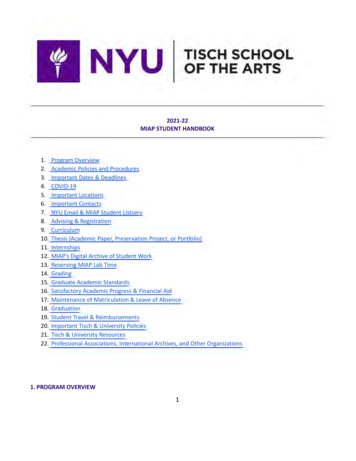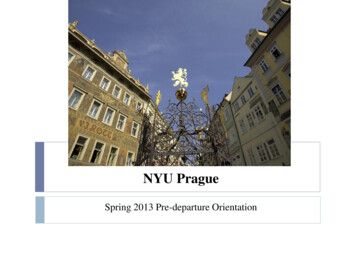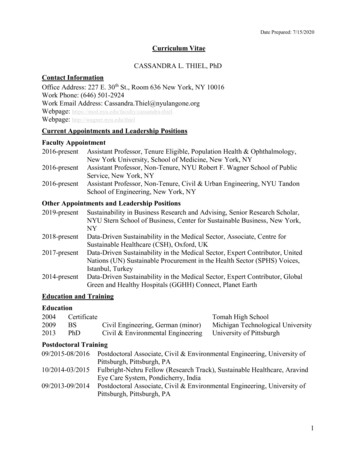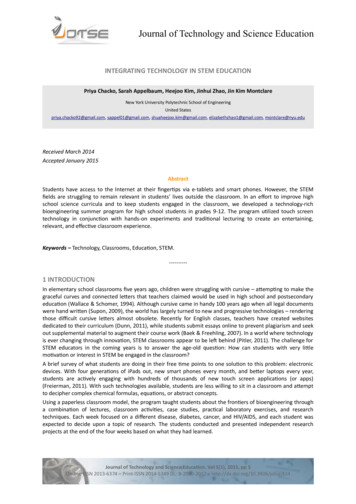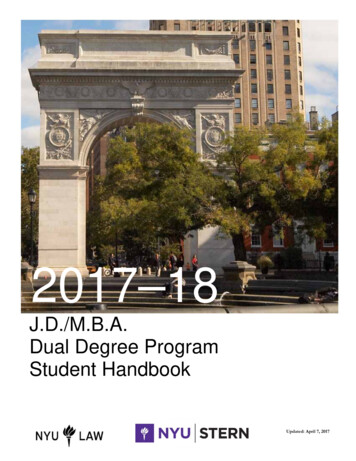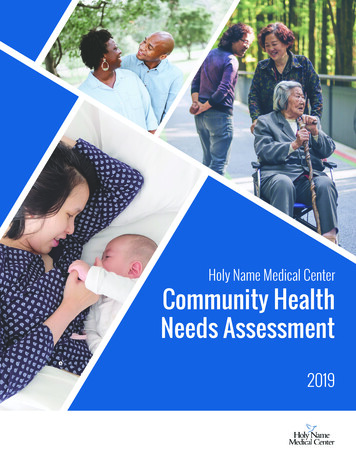
Transcription
Burde, D., J. Middleton, and C. Samii. 2017. Assessment of Learning Outcomes and Social Effects of CommunityBased Education: A Randomized Field Experiment in Afghanistan. ALSE Household Survey Training Manual. NewYork: Steinhardt School, New York University.NYU ALSE HOUSEHOLD SURVEYTRAINING MANUAL1Copyright 2017 by Dana Burde, Joel Middleton, and Cyrus Samii
Principal InvestigatorDana Burde, Steinhardt School, New York UniversityCo-Principal InvestigatorsJoel Middleton, Steinhardt School, University of California, BerkeleyCyrus Samii, Department of Politics, New York UniversityResearch DirectorCornelia SageProject DirectorMohammad Amin SadiqiDeputy Research DirectorOtgonjargal OkhidoiSenior Research ConsultantAhmad Saeed Mahmoodi2Copyright 2017 by Dana Burde, Joel Middleton, and Cyrus Samii
Table of ContentsIntroduction . 5Before you begin . 6Selecting respondents . 6Reading and recording answers . 6Informed consent . 10Important instructions . 11Figure one: implementation process for the household survey . 12Survey Management Information . 13Part 2: Greetings and introductions. 17Part 3: Consent . 20Section I: Head of Household Information . 23Section II: Collection of Information for Child Learning Assessment Participants . 28Section III: Household demographics . 32Section IV: Education of Boys . 36Section V: Education of Girls . 42Section VII: Parental Involvement in Education . 51Section VIII: Children with Disabilities . 55Section IX: Perceptions of CBE . 57Section X: Educational Authorities. 61Section XI: State Authorities . 64Section XII: Demographics. 67Annex 1: Completing Multipart Questions . 723Copyright 2017 by Dana Burde, Joel Middleton, and Cyrus Samii
: This manual belongs to: Interviewer Code: Name of supervisor4Copyright 2017 by Dana Burde, Joel Middleton, and Cyrus Samii
IntroductionThis training manual is for the household and community leader questionnaires of the wave fourdata collection for the Assessment of Learning Outcomes and Social Effects of Community-BasedEducation in Afghanistan (ALSE): A Randomized Field Experiment. Data will be collected fromSeptember to November 2017 from 181 villages in 6 provinces: Bamiyan, Daykundi, Ghor, Herat,Kapisa, and Parwan. Thirty-five households will be interviewed for the Household Survey in eachvillage. One interviewer will conduct each household survey. Each survey should take approximately1 to 1.5 hours to conduct. This research is being done in partnership with two NGOs—CARE andCRS—who are establishing and supporting community-based schools in all communities. CARE issupporting schools in Parwan and Kapisa provinces; CRS is supporting schools in Bamiyan,Daykundi, Ghor, and Herat provinces. In early 2014, CARE and CRS established community basedschools (CBE) in 131 villages. They also established CBE in 44 other villages in 2016. Additionally,there are 6 villages in the sample where a CBE has been established by another NGO. You willconduct the Household Survey in villages where there is already an established CBE.ALSE/NYU facilitated the transfer of 69 CBE classes in 62 villages to local community institutions(Community Development Councils. Education Shura (School Shura)/Education Subcommittees,and School Management Shuras) in March 2017. While these three institutions are supporting themanagement and administration of these classes, ALSE/NYU is providing some financial support.This transfer was done in order to test whether local community managed CBE is a sustainableoption for the continuation of CBE at the village level.The village breakdown by organization:ALSE/ NYU62 VillagesCARE50 VillageCRS63 VillagesOther NGO6 VillagesThese interviews must be conducted professionally and according to the guidelines outlined in thismanual. Project Associates hired by NYU will randomly accompany teams of surveyors tovillages to ensure that all are adhering to these guidelines. These visits will occur randomlyso you will not know in advance when the Project Associates will come to observe yourwork. If it is found that you are not adhering to the guidelines set forth in this manual, youmay be withdrawn from working on the survey and barred from future work on the ALSEproject.Please make sure that villages know that you do not work for either CRS or CARE and thatthe answers that they give to your questions not affect the NGO’s support for the school intheir community.Finally, you should try to receive truthful responses from respondents interviewed. To do this, makesure to have a good relationship with those you interview and to make sure that they trust you. TheyIMPORTANT GUIDELINES Know and follow all guidelines in this manualDo not represent yourself as working for either CRS or CARE5 CRS/CARE, and NYUMake sure your behaviour reflects well on ACSOR,Make sure interviewees feel comfortable and know that you will not share their answers with anyoneCopyright 2017 by Dana Burde, Joel Middleton, and Cyrus Samii
should know that their answers will not be shared with anyone and that there are no right or wronganswers to any question.Before you beginSelecting respondentsThe household survey should be completed with the head of household (HoH): the primarydecision-maker for the household. If the HoH is unavailable, you should make an appointment toreturn to the house to interview the HoH later.If you are in the village for just one day, you should return to the household at least once that day totry to conduct the interview. If you are in the village for more than one day, you should also returnto the household at least once more on each subsequent day.If the HoH will be unavailable for the entire time you are in the village, you should interviewanother adult decision-maker from the household. If multiple adults are available and willing to beinterviewed, you should interview the person who is responsible for making decisions in the absenceof the HoH. This person should be knowledgeable about the education status of the children in thehousehold.If no adult member of the household is available to be interviewed on any of the attempts to visitthe household, you should replace that household following the instructions in the Enumeration andSampling Guidelines.IMPORTANT GUIDELINES You should interview the head of household (the primary decision maker)If you cannot interview the head of household, interview the person who is responsible for makingdecisions when the head of household is not there.Reading and recording answersYou will complete a survey questionnaire with each head of household. The survey has differenttypes of questions with different instructions for completing the answers. Below are the main typesof questions. Each question has a different symbol associated with it throughout this guide. Everytime you see that symbol, you should follow the instructions for that type of question.6Copyright 2017 by Dana Burde, Joel Middleton, and Cyrus Samii
Important Guidelines When reading the questions, you should read all response options out loud unless itspecifically says DO NOT read responses, in which case you must not, under anycircumstance, read the response options out loud. For each question, circle only ONE response, unless directed to select all that apply in whichcase you must circle all the responses the respondent mentions.Types of QuestionsþSELECT RESPONSE: Circle the numeric code associated with the response option that therespondent chooses, using the picture below as an example:*This is the most common type of question on the survey*@OPEN ENDED QUESTION: Write down the respondent’s answer.KOPINION SCALE: Read all answer options (e.g. strongly agree / agree / disagree / stronglydisagree). Make sure to capture the respondent’s degree of agreement. For example, such as “Isort of disagree,” ask for clarification by saying “so, would you say that you strongly agree, agree,disagree, or strongly disagree? Please pick the one that is closest to your own opinion.” Do notindicate what your opinion is or whether you think that there is one answer that is better thanothers.If the respondent refuses to provide an answer, then you should still mark the appropriate code(97, 98 or 99 – see below).For battery style questions that have this type of opinion scale, make sure to read all responseoptions for each battery portion. Do not just read the scale once at the beginning of the question.XSTOP AND OBSERVE: Do NOT ask this question to the respondent directly. Observe theanswer and circle the appropriate response on the survey.ROSTER: These questions track information for the same boys or girls. List all boys or all girlsfirst. Then ask all questions on that page for one child before moving on the next child. This willhelp make sure that you do not get confused about which child you are discussing.TO BE COMPLETED BY YOUR SUPERVISOR: There are a few questions on your surveythat are to be completed by your supervisor, or by ACSOR either before or after the survey is7Copyright 2017 by Dana Burde, Joel Middleton, and Cyrus Samii
conducted. You do not need to mark a response for these questions.Common InstructionsSome questions have instructions about how they should be read. Below are the most commoninstructions in the survey. Do not read these instructions to the respondent.&READ ALOUD: Read all questions aloud to respondents. In addition, you should readsome passages of text word-for-word.ÖSKIP PATTERN: Some questions will be skipped depending on the answer to aprevious question. For example,Q22a. Does [NAME] currently study at a community based class?1. Yes (Skip to Q22c)2. No (Skip to Q22b)If the respondent answers “yes” then you continue, follow the instructions and skipahead to Q22c. If the respondent answers “no” continue with the next question in thesequence (Q22b). FOLLOW UP ACTION IS REQUIRED: Some questions require additional actionon your part. For example, you may need to verify the information provided by therespondent against existing records or previous responses.Standard Answer choicesSome answer choices are standard throughout the survey and should be used when the respondentdoes not provide an answer. You should never read these answer choices out loud.97Use this code for questions that have not been asked—for example, if you follow a skippattern, use this code for the questions that you skip.98Use this code if the respondent says that they refuse to answer the question. Youshould use this code rarely. If the respondent refuses to answer a question, you shouldencourage (but not pressure) the respondent to answer by telling him that his answerswill not be shared with anyone and that his answers will have no effect on education inhis community. (See also guidance note 2 on asking sensitive questions).99Use this code in cases when the respondent does not know the answer to a question. Ifthe respondent is confused about a question, you can re-explain the question usingdifferent words. This code should almost never be used in relation to an opinionquestion.@‘OTHER’ ANSWER CHOICE: Some questions have an answer choice that allowsyou to write down the respondent’s answer if it is not included in the numeric list ofanswer choices. If this happens, you should circle the number associated with “other”and write the respondent’s answer on the blank line.8Copyright 2017 by Dana Burde, Joel Middleton, and Cyrus Samii
Interviewers should never suggest to a respondent that there is any correct answer. Respondentsshould feel free to give the answer that they think is most appropriate. If a project monitor findsthat an enumerator is suggesting a correct answer to a respondent or pressuring a respondent toanswer a certain way, she or he may not be paid for his or her work, and may be removed fromworking on this project.O GUIDANCE NOTE 1: CONSISTENCY AND OBJECTIVITYIt may be tempting to give respondents your opinion on a topic as you ask questions or try to guess what therespondent would say. However, this reduces the quality of the data collected, since the respondents may want tosay they agree with you even if they do not. Even if you explain a question, it is important that you do not provideyour opinion.To get the best quality data, you should: Read the questions exactly as worded Provide all answer choices every time you ask a question, unless other instructions are given If the respondent does not understand a question, reword or rephrase according the guidelines providedin this manual. Never provide your own opinion. If the respondent is uncertain about a question, ask him or her toestimate his opinion and/or remind him that there is no correct answer. Record respondent’s answers precisely, even if you do not agree with them.9Copyright 2017 by Dana Burde, Joel Middleton, and Cyrus Samii
Informed consentInformed consent is a very important part of any research. It is an agreement established betweenyou—the surveyor—and the respondents, and it must be respected at all times. Informed consentrequires that you discuss the purpose and goals of the research with the respondents and that therespondents voluntarily agree to participate in the research. Informed consent is taken at thebeginning of the interview, when you read the consent script) and ask the respondent to participate(Part 3 of Survey Management). Informed consent also means that at any point during the interview,a respondent may decide to end the interview.If this happens, you should reiterate that no information the respondent gives will be traceable backto her or him. You can also indicate approximately how much time the remaining portion of theinterview will take. If the respondent still refuses to continue the interview, you should thank her orhim for their time, and leave the home. This guide and the survey include all the information youneed to ensure that informed consent is respected (see also Part 2 of Survey Management: Greetingsand Introductions and Part 3 of Survey Management Consent, below).O GUIDANCE NOTE 2: ASKING QUESTIONS ABOUT SENSITIVE TOPICSCertain parts of this survey ask people about their cultural and social context. These questions may touch uponsensitive topics, particularly in the context of insecurity and conflict in Afghanistan. A question that is sensitive maygenerate an emotional response from respondents. This may occur even in cases where you yourself do notbelieve a question to be of a sensitive nature since reactions can depend on the personal biographies ofrespondents and thus cannot be predicted. Emotional responses may include: anger, upset, discomfort, anxiety, orstress. A respondent may have an emotional response to the question even if they do not show that responseverbally or physically. These responses may occur for different reasons, including the fact that they feel judged,misrepresented, or endangered. For your safety as well, as the safety of the respondent, it is important to beaware of these possibilities and to be able to respond appropriately.The following advice can minimise problems:When asking questions-Ask questions exactly as worded. All questions have been designed to avoid emotional responses asmuch as possible. If you need to re-explain a question using different wording then you should do so in away that avoids bias or presenting your opinion.At all times, respect a respondent’s decision not to answer a question. You can encourage a respondentto answer but never pressure a respondent to answer a question or give the impression that you areunhappy with their response. Pushing someone to answer questions they do not understand or forcingthem to answer in cases where they claim not to have an answer or opinion can generate frustration andundermines the trust between yourself and the respondent.When observing responses-Pay attention to how respondents react to questions. This includes not only verbal frustration but alsotheir body language. If a respondent verbally or physically shows discomfort you should:10Copyright 2017 by Dana Burde, Joel Middleton, and Cyrus Samii
-o Pause and reassure them about the purpose of the questiono Tell them that their answers will not be shared with anyone elseo Tell them that they do not have to respond if they are uncomfortable doing so.Be careful how you react to the responses provided. Your behaviour may convey shock or surprise thatcould offend or upset the respondent. This includes visibly expressing your disagreement (eye rolls,frowning and other expressions of surprise).Important instructionsThe survey includes twelve sections in total. Each section collects information on a different topic.The following sections in this manual provide an overview of each section. This is followed by moredetailed information and instructions about each question. In each section, space is provided for youto take notes during the training.11Copyright 2017 by Dana Burde, Joel Middleton, and Cyrus Samii
Figure one: implementation process for the household surveySTART: Approach thehouseholdRead the script for theinformed consentRespondent Says NoThank respondent fortheir time and moveto the next householdRespondentSays YESRespondent is UnavailableIf HOH is unavailable,make appointment tointerview them laterthat day or the nextdayAsk for permission to speak with the children in thehousehold. If the head of household gives permission tointerview only some of their children, but not all, proceedwith the learning assessment with the children for whomthe permission was granted.Respondent Says YESOnce the survey iscomplete thank therespondent for theirtime and move to thenext householdProceed with thesurvey, following thesteps in the field guideand survey textSecond interviewerwill proceed with thelearning assessmentwhile you completehousehold survey12Copyright 2017 by Dana Burde, Joel Middleton, and Cyrus SamiiRespondent Says NoContinue with the household surveybut tell the learning assessmentinterviewer that the children will not beinterviewed. Once the survey iscompleted thank the respondent fortheir time.
Survey Management InformationPart 1: Survey DataSECTION 1 AT A GLANCE This section of the survey includes 26 questions (H.1, E.1 and M.1 to M.23). It collectsmanagement information on the sample, community, and household family beinginterviewed.There is one multi-part question (Question 11).XAll of the questions in this section should be answered by observation only!Questions E.1 and M.2 to M.13 should be completed BEFORE you approach thehousehold.13Copyright 2017 by Dana Burde, Joel Middleton, and Cyrus Samii
NOTESINSTRUCTIONSQUESTIONTo be completed by your supervisor after the interview.X Observation only. Complete before approaching household.H1. Household Packet NumberE1. Enumeration IDThe enumeration ID is the number written on the house door bythe enumeration team.To be completed by ACSOR prior to fieldwork.X Observation only. Complete before approaching household.M1. Wave NumberM2. Regionþ Select response from list providedTo be completed by ACSOR prior to fieldwork.M3. Sampling Point/ District Wherethe Interview Was CompletedM4. Household GPS CoordinatesX Observation only.@ Write in the response provided.You will use your phone to take a picture of the house. Record the GPS coordinates ofthe house at a time that is convenient and in a manner that is discrete.X Observation only. Complete before approaching household.þ Select response from list providedM5. Geographic CodeMark only 1. Villages.X Observation only. Complete before approaching household.M6. Provinceþ Select response from list providedMark only the province where you are surveying: 2. Kapisa, 3. Parwan, 24. Herat,31. Ghor, 32. Bamyan, or 34. Daykundi.X Observation only. Complete before approaching household.14Copyright 2017 by Dana Burde, Joel Middleton, and Cyrus SamiiM7. Year of interview
Please record the year (2017). Do not record the year according to the Afghan calendar.X Observation only. Complete before approaching household.M8. Month of interviewX Observation only. Complete before approaching household.M9. Date of interviewX Observation only. Complete before approaching household.M10. Day of week of interviewþ Select response from list provided.@ Write in the response provided.þa.b.c.Select response from list provided.X Observation only. Complete before approachinghousehold.@ Write in the response provided.X Observation only. Complete before approachinghousehold.@ Write in the response provided.X Observation only. Complete before approachinghousehold.þ Select response from list provided.M12. Interview completed on the X Observation only.þM11. (Multipart question – 3 parts)Select response from list provided.Select whether you had to visit the household 1, 2 or 3 times in order to complete theinterview.X Observation only. Complete before approaching household.X Observation only. Fill in the start time of the interview.@ Write in the response provided.Record the time starting from when Q1 – the first question in Section 1 - is asked.X Observation only. Fill in the end time of the interview15Copyright 2017 by Dana Burde, Joel Middleton, and Cyrus SamiiM13. Supervisor codeM14. Record Time (using 24 hourclock) interview beganM15. Record Time (using 24 hour
@ Write in the response provided.clock) interview endedAfter you finished the last question (D11), record the time. If the respondent ends theinterview early, record the time it is when the respondent stated that s/he no longerwished to continue. You should fill in all four data positions.X Observation onlyM16. Record the length of theinterview in minutes@ Write in the response provided.To be completed by ACSOR prior to fieldwork.M17. Date Formatted Field.To be completed by ACSOR after fieldwork.M18. Keypuncher codeM19. Language of the interviewX Observation onlyþSelect response from list provided.To be completed by ACSOR after fieldwork.X Observation onlyþM20. Coder codeM21. Language of the QuestionnaireSelect response from list provided.@ Write in the response provided.Ö Response causes skip patternM22. Name of Head of Household@ Write in the response provided.M23. Name of RespondentTo be completed by ACSOR after fieldwork.If the respondent is the head of household, leave this answer blank.16Copyright 2017 by Dana Burde, Joel Middleton, and Cyrus Samii
Part 2: Greetings and introductionsPART 2 AT A GLANCE This section sets the tone for the rest of the interview and for gaining informed consent.You should approach the selected dwelling and ask to speak with the head of household(HoH). If the HoH is not there, you should ask to speak with another adult who isknowledgeable about the household and decision-making. If there are multipleappropriate adults available and willing to be interviewed, please ask to speak withwhichever individual is responsible for making decisions for the household when the HoHis not there.If no one answers the door or if no one is available at this household, indicate this on thecontact sheet attached to your questionnaire and mark the reason that you were notable to do the interview. Then, proceed to the replacement household following thesampling plan.IMPORTANT NOTE: Once the head of the household or another adult who isknowledgeable about the household is identified, you should introduce yourself byreciting a consent script included in the survey and provided below.& You must read the script provided in Part 2 (Greetings and Introductions) word forword. Make sure that the village has a CBE school.17Copyright 2017 by Dana Burde, Joel Middleton, and Cyrus Samii
NOTESINSTRUCTIONSSECTION& Read the script provided for Part 2 out loudPart 2(Greetings and Introduction. [Please check with your supervisor and make sure that the village you arevisiting has a community-based education class. The community-based education classes could besupported by either CARE, CRS, ALSE, MoE or another organization. If there is a CBE class usescript 2a if there is no CBE class use script 2b.]2a. For villages with a CBE class. (To be read aloud)Assalam o Alakum, my name is (and this is ). We work forthe Afghan Center for Socioeconomic and Opinion Research (ACSOR), an independent researchorganization working in Afghanistan. We are studying community-based classes, also called CBE, inyour village. You may remember that we visited your village two years ago to ask questions abouteducation in your village. We are here this year to follow up on those questions and also to find out alittle bit about the CBE that is here. As we mentioned last time, we do not work for the organizations thatare administering the CBE class, but do some work in partnership with them. We would like to speakwith you now. Our conversation will take approximately one hour to 75 minutes. Please understand thatyour responses to this survey will have no effect on the CBE class in your village. However, we do hopethat our research contributes to better education service delivery across Afghanistan.I’d like to ask you some questions about your household and your children’s education. In addition,while you and I talk, my colleague would like to give the children who are between the ages of 6 to 13years old a short math and Dari/Pashto test. I’d like to speak with each child individually, if that is okaywith you. I have a short form for the assessment that I can show you. The test will take 20 minutes perchild.Your participation may help us understand the process of delivering better education services in[BAMIYAN/DAYKUNDI/GHOR/HERAT/KAPISA/PARWAN] province. You may end the survey atany time, or refuse to answer any questions that you do not want to answer. We very much appreciateyour participation. You are being very generous with your time.18Copyright 2017 by Dana Burde, Joel Middleton, and Cyrus Samii
2b. For villages without a CBE class. (To be read aloud)Assalam o Alakum, my name is (and this is ). We work forthe Afghan Center for Socioeconomic and Opinion Research (ACSOR), an independent researchorganization working in Afghanistan. We are studying community-based classes, also called CBE, acrossAfghanistan. You may remember that we visited your village two years ago to ask questions abouteducation in your village. We are here this year to follow up on those questions. Your participation mayhelp us understand the process of delivering better education services in[BAMIYAN/DAYKUNDI/GHOR/HERAT/KAPISA/PARWAN] province.We would like to speak with you now. Our conversation will take approximately one hour to 75 minutes.You may end the survey at any time, or refuse to answer any questions that you do not want to answer.We very much appreciate your participation. You are being very generous with your time. Pleaseunderstand that your responses to this survey will not influence education in this village. However, we dohope that our research contributes to better education service delivery across Afghanistan.I’d like to ask you some questions about your household and your children’s education. In addition,while you and I talk, my colleague would like to give the children who are between the ages of 6 to 13years old a short math and Dari/Pashto test. I’d like to speak with each child individually, if that is okaywith you. I have a short form for the assessment that I can show you. The test will take 20 minutes perchild. You may end the survey at any time, or refuse to answer any questions that you do not want toanswer. We very much appreciate your participation. You are being very generous with your time.Notes to interviewer: Do not read instructions inside parentheses “( )” orbrackets “[ ]”. Read all questions aloud word for word. Read all answer choicesaloud unle
TRAINING MANUAL Burde, D., J. Middleton, and C. Samii. 2017. Assessment of Learning Outcomes and Social Effects of Community- . Cornelia Sage Project Director Mohammad Amin Sadiqi . 62 Villages 50 Village 63 Villages 6 Villages These interviews must be conducted professionally and according to the guidelines outlined in this
